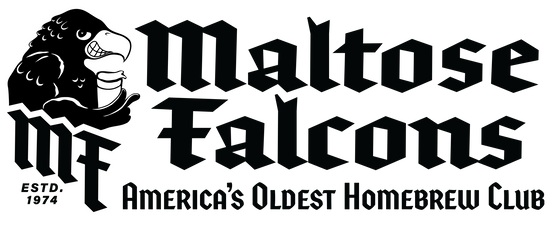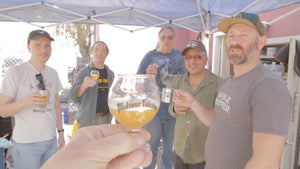Tripppel Trubbel Shop Brew
I took on the task of refurbishing the Falcons’ Brewing System at the shop last year, and had the chance to put it through its paces last Sunday, when I led a Belgian Tripel Shop Brew. We had a crew of 5 seasoned brewers sign up: Adam Severi, Adrian Febre, Art Fitzsimmons, Jason Naylor, and myself - a crack team with no slackers.
PRE-BREW DAY
I was in touch with the crew 10 days out, sending out the liability releases, planning the recipe, and also confirming that starters would be ready to pitch on brew day. We decided to each use a different Belgian yeast - comparing beers will be interesting. Here's the as-brewed recipe: Tripppel Trubbel. (I figured if the Belgians can spell dubbel with 2 Bs, a tripel warrants 3 Ps.) It has a simple grain bill with 88% Dingemans Pils, a hochkurz step mash, 90 min boil, and comes in ~ 9% ABV.
Jason and I went to the shop a couple of days earlier to prep and clean the system and check all hoses, fittings, pumps etc. The rig had not been used in 2 ½ months - and we did not want any surprises on brew day. I also grabbed a water sample from the shop, and Adam did a water analysis. It was too high in alkalinity (120 ppm) for what we were brewing. Not wanting to adjust the water with a ton of acid, I opted instead to cart 35 gallons of RO water from home for the mash.
BREW DAY
The weather gods were smiling at us on brew day with sunny skies and a high of 71°. Three of us got there at 7:00 to fill the kettles and fire the burners, and the rest arrived around 8:00. Here was our pre-planned rough timeline:
8:00 Assign tasks/responsibilities, followed by weighing and milling
9:00 Dough-In
10:30 Lauter/Sparge
12:00 Boil
1:30 Flameout
2:30 Start transfer to carboys
4:00 Wrap up after finishing cleaning (maybe sooner if we run a tight ship)
The day started out with a couple of early squawks. The MT burner would not fire, but this did not faze us - we pumped the strike water to the BK to heat, then pumped it back. The HLT temp probe also turned up inoperative (shorted), so we used the MT probe as our control. Weighing, milling, and dough-in went smoothly, and we nailed our initial mash temp at 144°.
HERMS regulated the temperature with a 3° offset. We circulated the mash through HERMS continuously with the pump wide open, except for about 10 minutes when the HLT got a few degrees ahead.
Other than the step up to 160° taking a bit longer than anticipated, mashing was uneventful. Mash efficiency was in the high 70s, (thanks to Rick Morales for lending us his Blichmann false bottom), and runnings were crystal clear. In retrospect, the 2 lbs of rice hulls we added as a safety buffer were probably not necessary.
One of the purposes of these Shop Brews is to fulfill a core mission of the Falcons: brewing education/knowledge transfer. Even though there were no novices amongst us, brewing with others can always teach you a thing or two. These are the lessons I learned on this brew, the first three are specific to the club’s system:
-
Break the siphon in the BK copper recirculating wand before disconnecting its hose from the pump, or it will dump wort all over you. We may want to think about adding a valve to this wand.
-
Constantly monitor lauter output into BK to look for stoppages. The new Blichmann Riptide pumps have a linear flow valve that lets you control your lauter rate very slowly and precisely - until an errant grain blocks it, and the rate slows to a crawl or stops. (One then has to crack it open a hair, followed by turning it back down).
-
If you don't use a pickup screen on the BK drain, check orientation of dip tube before filling BK to ensure that it is angled to pull from a few mm above bottom (I think we had it straight down, based on the break visible in the carboys)
-
Don’t trust your refractometer blindly - this one was a doozy. I was aware that the refractometer correction factor (CF) changes slightly based on the wort. I had previously come up with a correction factor of ~1.02 for worts around 20 brix. The actual CF for this wort was 1.075 - way higher than expected, resulting in an erroneous OG reading 5 points too high. I suspect this may have had to do with the syrupy boiled early runnings. Our actual OG measured on a hydrometer ended up bang on the money at 1.079.
-
Replace your pH probe when it requires multiple attempts to calibrate it, or if it starts drifting. I’m told that non-fillable probes last a year at best, even if stored properly. Our second pH reading was considerably higher than the first taken at 20 min in, so we decided to add some acid before the alpha rest just to hedge our bets.
-
If using hop bags (I normally don't), have some rocks or ball bearings handy to prevent them from floating. We ended up holding them down with a mash paddle.
We fired up the BK burner as soon as we had about 2 gallons of runnings. Because we were lax In vigilantly monitoring the lauter flow rate, (see lesson #2 above), we boiled the heck out of the early runnings because of stoppages. This vigorous boiling of initial runnings resulted in a higher SRM and some great kettle caramelization. (John A. would have been proud!) Because of this extensive boil-off during the lauter, we ended up with an effective boil time way longer than the 90 min we timed after reaching pre-boil volume.
I had brought my SS counterflow chiller to use for a second pass from BK to carboy, along with an immersion pump and ice. Adam had the brilliant idea to use the CFC in tandem with the club’s immersion chiller, using a spare garden hose connected to a hose bib. We were able to get 38 gallons of boiling wort to 80° in just over half an hour with 58° groundwater. A subsequent pass using iced water through the CFC resulted in very fast transfers (through Adam’s inline oxygenator) to the carboys. Total chilling/transfer time from boiling (kettle) to low 60° (6 carboys) was under an hour.
Everyone pitched in with the cleaning, staying ahead of the game. We had no spent grain to dispose of, as Art and Jason hauled it all away for composting. We did not fall too far behind our timeline, and wrapped things up around 5:00.
WRAP UP
All-in-all it was a busy but enjoyable and stress-free day, mainly due to the great team effort. The experience level and resourcefulness of the crew helped immensely in dealing with issues on the fly. Also, planning ahead did not hurt.
I urge members to attend Shop Brews, either as participants or leaders. Yes, it is a lot of work. And yes, it does take up the better part of a day. But home brewing is all about the rewards, and they are aplenty. And you may pick up a useful technique or two.
Here is a link to the Operation Guide and associated files. You may want to read the guide if you plan to attend or lead a Shop Brew, and are not familiar with the system. Art is putting together a video piece to go alongside the guide. As part of the video knowledge base, I created maintenance videos for the new Riptide pumps purchased in 2022.
The Falcons Brewing System is a terrific resource for the club, and we should take full advantage of it, while ensuring it is properly used and maintained.
Cheers!

